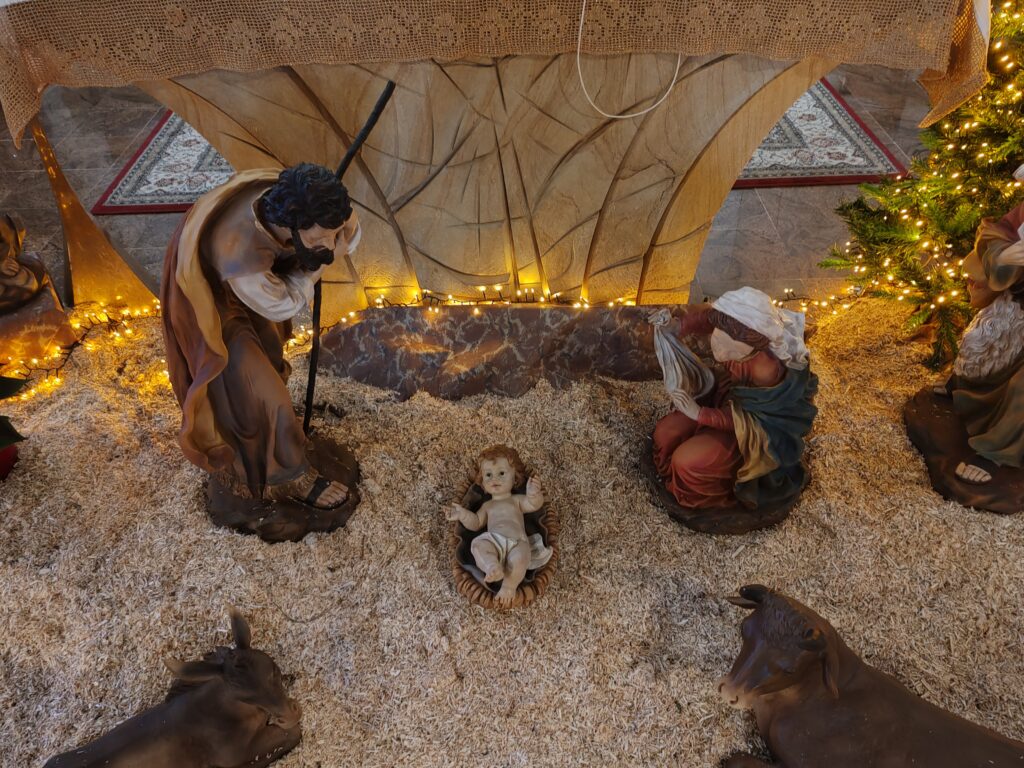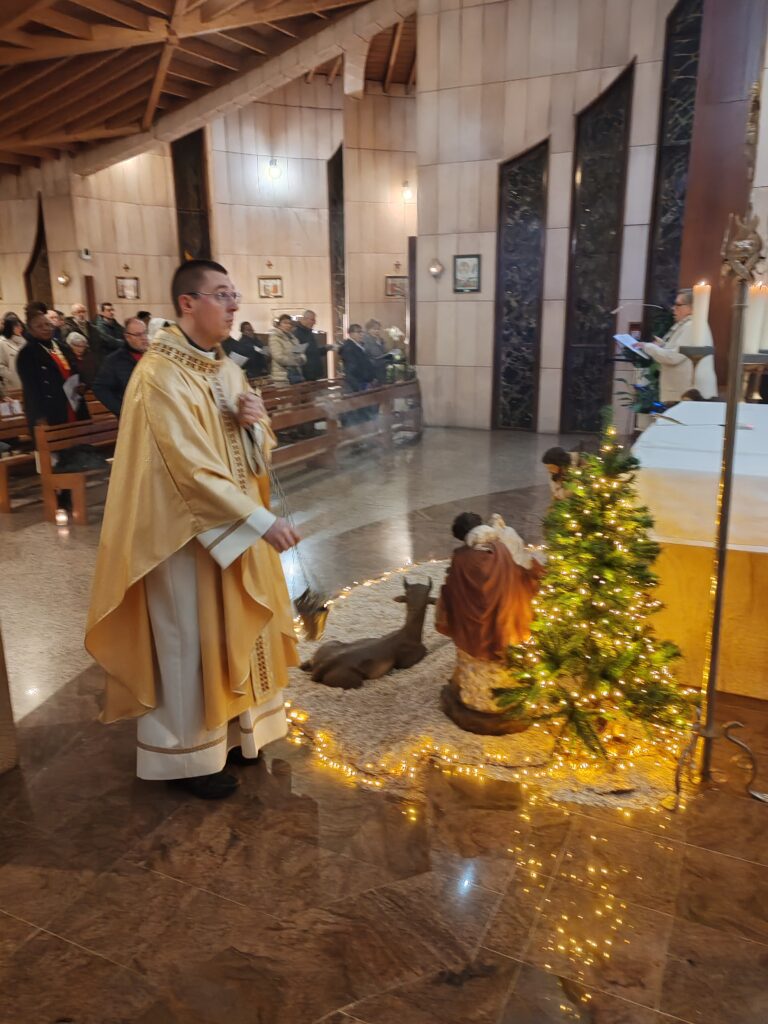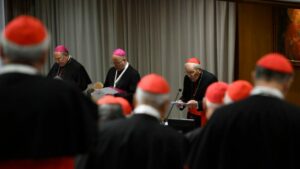After the twelve strokes of midnight, the celebration of Christmas begins with this magnificent carol: “The divine child is born, let us all sing of His coming”. “It is for every man that He is the true light”. .
Father Guillaume Charbonneau OMV meticulously presides over this celebration of the Night where Light shines in the darkness, and invites us to carry the world in our contemplative prayer of the Infant God.
It’s at the “Gloria” that all the lights in the chapel will come on, and the bells will ring out the immeasurable advent of the Incarnation of the Son of God in our midst.
Far from being a folkloric fact, it is first and foremost a historical one, confirmed by the prophecies of the Old Testament, which place it in the perspective of a Promise made by God (Yahweh): The people who walked in darkness have seen a great light rise up; and over the inhabitants of the land of darkness, a light has shone. Yes, a child has been born to us, a son has been given to us! (Isaiah 9:1; 5). So not only is the Infant Jesus in a manger, as he was two thousand years ago, but liturgically he is also in our hearts, this time awaiting his definitive return to us at the Parousia.
In an interview with writer and historian Jean-Christian Petitfils, conducted by Manuella Affejee of Vatican News, the two discuss the historical background to the Bethlehem event.
Here it is in full:
Since the introduction of the Nativity on December 25, the day of the pagan feast of Sol invictus, the precise date of Jesus’ birth has been hotly debated. Has it ever been determined?
One thing’s for sure: Jesus wasn’t born on December 25, Year I, as tradition has it. It was not until the 4th century that Pope Liberus (352-366) instituted the solemnity of the Nativity, in order to Christianize the winter solstice feast of Sol Invictus. According to the Gospels of Matthew and Luke, Jesus was born in the time of King Herod. However, Herod died in 4 (or 2) BC. A miscalculation by a 6th-century monk, Denys the Lesser, led to the adoption of the year I date.
Can we say with certainty that today’s Basilica of the Nativity, one of the oldest Christian buildings in the world, stands on Christ’s birthplace?
Saint Justin, a Palestinian from Nablus, was the first, around the year 160, to mention a venerated grotto near the village of Bethlehem that the emperor Hadrian had desecrated a few years earlier: “As Joseph had nowhere to stay in the village,” he writes, “he settled in a grotto near Bethlehem, and it was while they were there that Mary gave birth to Christ and placed him in a manger“. Archaeology has confirmed these findings: Jesus was indeed born beneath today’s Basilica of the Nativity.
“And it came to pass in those days that there went out an edict from the emperor Caesar Augustus, commanding a census of all the inhabited world“, recounts Luke’s Gospel. Is this census a historical fact?
The census of Quirinus, governor of Syria, mentioned by Luke to justify Mary’s move from Nazareth to Bethlehem, poses some chronological difficulties, since this tax-related operation dates only from 6 CE. According to some historians, it was an earlier census, begun in 8 B.C. and lasting two or three years. Note that this was certainly not an imperial edict aimed at “the whole earth”, as Luke emphatically writes.
The same evangelist, speaking of Jesus’ parents, affirms that they belong to “the line of David”. What do we know about this royal ancestry? What does it imply?
Jesus belonged to a small Jewish clan, the Nazarenes (or Nazoreans), who returned from exile in the second century BC and claimed descent from King David. These people, who were awaiting the birth of a messiah in their midst, as prophesied by Isaiah (“An offspring will come forth from the stock of Jesse…”), had founded a village in Lower Galilee called Nazara (Nazareth), netzer the “sucker” (in other words, the “offspring” of Jesse, father of David). But many pious Jews doubted: “Can anything good come out of Nazareth?” (John 1:46). According to the latest archaeological research, Nazareth in the first century was a fairly large village of around a thousand inhabitants, far from the main traffic arteries.
Joseph, Jesus’ adoptive father, was neither a peasant nor a construction worker, as some have said, but a craftsman, a wood technician(tektôn in Greek), which placed him in a slightly higher social category. It is quite possible that he was considered the heir of the Davidic clan, from which the Messiah was to be born. One of Jesus’ greatest difficulties during his public ministry was precisely to combat his identification with the political, warrior messiah everyone dreamed of to drive out the Romans.
As for Mary (Myriam in Hebrew or Aramaic), she most probably belonged to the same Davidic clan as Joseph. Her parents, named Anne and Joachim according to the Protevangile of James (a 2nd-century Christian apocrypha), seem to have lived in Sepphoris, the nearest town to Nazareth. Marriages were arranged between families, and it was almost impossible to deviate from these binding customs. As Hegesippus, a 2nd-century Jewish convert who collected precious details about Jesus’ family, wrote, “Mary appears to be of the same tribe as Joseph, for according to the law of Moses, it was not permitted to marry into tribes other than one’s own“. She was no mere daughter of Israel. As a descendant of David, nourished by Holy Scripture from her earliest childhood, she knew the promise made to her royal ancestor through the prophet Nathan: “Thy house and thy kingdom shall endure before me forever“. Hence Mary’s fiat at the angel’s announcement. The Lord, she sings in the Magnificat, has remembered “his mercy, as he proclaimed it to our fathers, for Abraham and his descendants forever“.
Naturally, historians cannot comment on the so-called virgin birth of Jesus, affirmed in the New Testament, the Apostles’ Creed and the Nicene-Constantinopolitan Creed. The fact is that this fact, more embarrassing than rewarding, embarrassed Christ’s first disciples, as it could lead them to believe that their master had been born illegitimate. During his lifetime, Jesus’ adversaries did not hesitate to accuse him of being “born of fornication“. For a long time, it was thought that, in Jewish tradition, a woman’s virginity was seen in a negative light (“Grow and multiply…”, says the Bible), until the discovery in 1967 by an Israeli archaeologist, Yigael Yadin, of a text from the Dead Sea Scrolls, in which there is mention of consecrated virgins and a vow of perpetual virginity within marriage itself: if a young girl “binds herself in her father’s house by such an oath“, the husband can disown her and release her from her commitment. She will then be held harmless. If he remains silent, the commitment is still valid. Is this the situation faced by Mary’s husband Joseph, who, Matthew’s Gospel tells us, had resolved to repudiate her in secret?
On learning of the birth of the “King of the Jews” in Bethlehem, Judea, King Herod decided to kill all the newborn babies in the town. The “Massacre of the Innocents” contributed to the black legend of King Herod. Do we know if this massacre actually took place? Do other sources mention it?
Herod the Great, king of Judea under whose reign Jesus was born, was not only the most prodigious builder of antiquity, whose architectural genius, commensurate with his folly of grandeur, transformed the landscapes of Israel, but also a cruel tyrant dreaming of being recognized by the Jewish people as the Messiah. The episode of the massacre of the Innocents, a dozen or so children from Bethlehem, is not attested by historical documents, but it’s quite possible that it really happened, given the paranoid psychopathy of the character who had one of his wives, his brother, his mother-in-law, two of his own sons and many of his officers beheaded.
What do we know about these Magi from the East? Is the star they are said to have followed just a detail invented to embellish the story, or is it a credible astronomical phenomenon recorded in other sources?
Only one text in the New Testament mentions the arrival of the Magi, the Gospel according to St. Matthew. It should be noted, however, that the Babylonian Talmud, which dates from around the 6th century but brings together very ancient traditions, refers to the arrival in the latter days of Herod’s reign of “gentiles” who would have gone to Jerusalem to see Jacob’s star rise.
Tertullian, a Christian author of the early 3rd century – inspired by Psalm 72, which speaks of the “kings of Tarcis and the isles” and the “kings of Sheba and Sheba” who came to bring offerings to the Messiah – made them kings, symbolically originating from the three known continents, Europe, Asia and Africa. Melchior, Gaspard and Balthazar are only mentioned in a text from the 6th or 7th century, Les extraits latins d’un Barbare ” Excerpta Latina Barbari “.
The story of the Magi is in fact linked to that of the star. Several hypotheses have been put forward on this subject. Halley’s comet or a supernova have been mentioned: bad omens in the spirit of the times, and therefore to be discarded. More interesting is the discovery in the 17th century by the famous astronomer Kepler of a conjunction between Jupiter and Saturn in the constellation Pisces, which occurred three times in the year – 7. In the 16th century, a Portuguese rabbi, Isaac Abravanel, had announced that the Messiah would be born when such a conjunction appeared. For the Jews, Jupiter was the symbol of Royalty, Saturn that of Israel, and the constellation Pisces (formerly known as the Tails) that of the Sea Lands, Palestine and Syria.
At the beginning of the 20th century, German archaeologist Schnabel found numerous cuneiform tablets on the site of the ancient Mesopotamian city of Sippar, 32 kilometers south of Baghdad, one of the most renowned observatories of the time. On one of them is an ephemeris confirming the appearance of this conjunction on three occasions in the year 7 BC. Scientific calculations have enabled us to determine the exact dates. The conjunction was visible between May 29 and June 8, then again between September 26 and October 3, a very important date as October 3 is the feast of Kippur, the great Jewish festival of forgiveness. This leads us to suppose that the Jewish Magi from the Diaspora who had remained in Sippar may have had the wish, based on the Jewish tradition of the star of the soothsayer Balaam, that this conjunction heralded the birth of the Messiah. They would have set off at that point, arriving in Jerusalem in late November or early December, in time to witness the reappearance of the star between December 5 and 15, according to Matthew’s text. At that moment, the“apparent star” was perfectly visible heading south, following exactly the path of the Magi as they made their way from Jerusalem to Bethlehem. This is certainly a hypothesis, but one that is sufficiently troubling to suggest that we are not dealing with a legend.





